The ultimate reference and tutorial to harness the power of
Revit MEP
This Autodesk Official Press book will help you develop your
expertise with Revit MEP's core concepts and functionality. Based
on the authors' years of real-world experience, this comprehensive
reference and tutorial has been updated to cover all of the new
features of Revit MEP, and includes best practices, techniques,
tips, tricks, and real-world exercises to help you hone your
skills.
* Shows how to use the interface effectively, explains how to
create and use project templates, and details ways you can improve
efficiency with worksharing and collaboration
* Addresses generating schedules that show quantities, materials,
design dependencies, and more
* Looks at creating logical air, water, and fire protection
systems; evaluating building loads; and placing air and water
distribution equipment
* Covers lighting, power receptacles and equipment, communication
outlets and systems, and circuiting and panels
* Zeroes in on creating water systems, plumbing fixtures and
their connectors, water piping, and more
Featuring real-world scenarios and hands-on tutorials, this
Autodesk Official Press book features downloadable before-and-after
tutorial files so that you can compare your finished work to that
of the professionals. It's the perfect resource for becoming a
Revit MEP expert.
Autorentext
Don Bokmiller is a CAD/BIM Specialist at Clark Nexsen Architecture & Engineering in Norfolk, Virginia. He has more than 15 years of experience in the AEC field and is a well-known AUGI forum participant. Simon Whitbread has over 25 years of experience in the construction industry. He is an Autodesk Certified Instructor who has taught Revit to students of all experience levels and is also a committee member for Revit Technology Conference (RTC). Plamen Hristov is the Director of Design Technology at Capital Engineering Consultants, Inc., and is leading the implementation of several BIM applications, including Revit. He lectures at Autodesk University, the Revit Technology Conference, and Ecobuild America, as well as at colleges and Revit User Groups.
Zusammenfassung
The ultimate reference and tutorial to harness the power of Revit MEP
This Autodesk Official Press book will help you develop your expertise with Revit MEP's core concepts and functionality. Based on the authors' years of real-world experience, this comprehensive reference and tutorial has been updated to cover all of the new features of Revit MEP, and includes best practices, techniques, tips, tricks, and real-world exercises to help you hone your skills.
- Shows how to use the interface effectively, explains how to create and use project templates, and details ways you can improve efficiency with worksharing and collaboration
- Addresses generating schedules that show quantities, materials, design dependencies, and more
- Looks at creating logical air, water, and fire protection systems; evaluating building loads; and placing air and water distribution equipment
- Covers lighting, power receptacles and equipment, communication outlets and systems, and circuiting and panels
- Zeroes in on creating water systems, plumbing fixtures and their connectors, water piping, and more
Featuring real-world scenarios and hands-on tutorials, this Autodesk Official Press book features downloadable before-and-after tutorial files so that you can compare your finished work to that of the professionals. It's the perfect resource for becoming a Revit MEP expert.
Inhalt
Introduction xxv
Part 1 • General Project Setup 1
Chapter 1 • Exploring the User Interface 3
The Ribbon 3
Using Tabs 4
Using Contextual Tabs 10
Using Family Editor Tabs 10
Customizing the Ribbon 12
Quick Access Toolbar 13
User Interface Features 14
Options Bar 14
Properties Palette 15
View Control Bar 17
Status Bar 21
Info Center 21
Exchange Apps 22
User Interface Control 22
Menus and Settings 23
Keyboard Shortcuts 25
Graphics 27
Context Menus 28
The Bottom Line 30
Chapter 2 • Creating an Effective Project Template 31
Understanding Templates 32
Understanding the Project Browser Organization 32
Determining Which Views Are Grouped Together 33
Sorting Views within Groups 34
Determining the Number and Types of Views Needed 35
Setting the Number of Levels 36
Working with Plan Types 37
Creating a Working View 37
Choosing Display Settings for Views 37
Visibility Settings for Template Views 39
Visibility Settings Shortcut: View Templates 45
Schedule Views 46
Establishing Project Settings 48
Object Styles 48
Drafting Line Settings 49
Export Settings 54
Annotation Styles 58
Project Units 62
Project Phases 63
Defining Preloaded Content and Its Behavior 66
Annotation Families 66
Component Families 68
System Families 71
MEP Settings 74
Creating Sheet Standards 77
Titleblocks 77
Sheet Organization 77
Preset Sheets (Not Placeholder Sheets) 78
The Bottom Line 81
Chapter 3 • Worksets and Worksharing 83
Understanding Central Files 83
Creating a Central File 84
Creating a New Workset 88
Working with Local Files 91
Creating a Local File 91
Synchronizing a Local File with the Central File 93
Managing and Using the Power of Worksets 96
Taking Ownership of Worksets 97
Working with Model Elements and Their Worksets 98
Controlling Visibility and Worksets 102
Enhancing Communication 106
The Bottom Line 108
Chapter 4 • Project Collaboration 109
Preparing Your Files for Sharing 109
Working with Linked Revit Files 112
Linking Revit Files 112
Using Shared Coordinates 115
Managing Revit Links 117
Controlling Visibility of Revit Links 119
Coordinating Elements within Shared Models 124
Monitoring Elements 125
Responding to Change Alerts 129
Reconciling Hosting 130
Maintaining Project Coordination 132
Working with Files from Other Applications 133
Linking CAD Files 133
Exporting Your Revit File to a CAD Format 136
Using Image Files in a Revit Project 138
Setting Options for Quality Control 141
Using Autodesk Revit Server 144
Using Cloud-Based Solutions 144
The Bottom Line 145
Chapter 5 • Multiplatform Interoperability: Working with 2D and 3D Data 147
2D Data Types 148
MicroStation 2D DGN 148
DXF 149
2D Data for Standard Details 149
2D Data for Plans, Sections, and Elevations 151
3D Data Types 158
Revit Project File 158
Revit Family File 161
ADSK 161
IFC 162
AutoCAD DWG 163
SketchUp 163
Other File Formats 163
Point Clouds 164
The Bottom Line 165
Chapter 6 • Parameters 167
...
